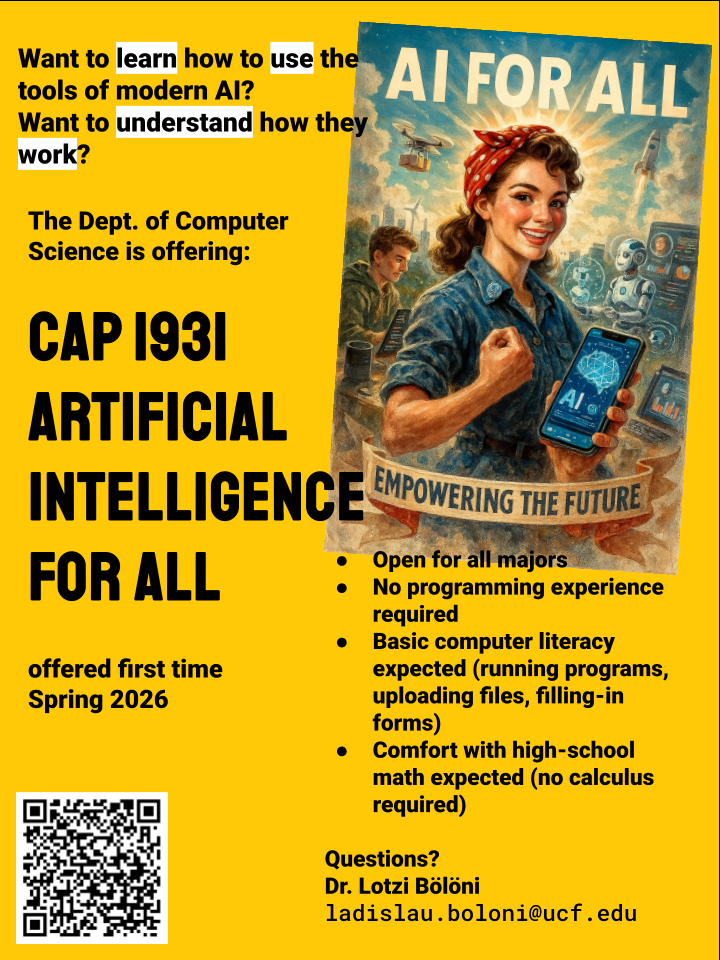Mon., Jan. 12
|
Introduction
- Class requirements
- Brief history of AI
|
|
Wed., Jan. 14
|
Using Jupyter notebooks
- vscode text editor
- Writing in markdown
- Jupyter notebooks
- Entering data
|
|
Mon., Jan. 19.
|
Martin Luther King day, no class.
|
|
Wed., Jan. 26
|
Using Jupyter notebooks (cont'd)
- Evaluating expressions
- Running python snippets
- Plotting graphs
- Showing pictures
|
|
Mon., Jan. 26
|
Machine Learning: Classification
- Classification problems
- One, two and many dimensions
- Classification techniques: linear classification, nearest neighbor
- Try it out: house vs. mansion
- Dangers and pitfalls: fairness
|
|
Wed., Jan. 28
|
Machine Learning: Regression
- Regression problems
- Regression techniques: linear regression, neural network regression
|
|
Mon., Feb. 2
|
Machine Learning: Regression (cont'd)
- Try it out: predict house prices in Orlando
|
|
| Wed., Feb. 4 |
Computer Vision: Image classification
- Image classification problems
- ImageNet and other datasets
- How it works: engineered features
- How it works: convolutional neural networks
|
|
Mon., Feb. 9
|
Computer Vision: Image classification (cont'd)
- Try it out: kitten or puppy
- Dangers and pitfalls: Illegal surveillance
|
|
Wed., Feb. 11
|
Computer Vision: Object detection and segmentation
- Object detection applications
- Segmentation applications
- How it works: convnet based object detection
- How it works: transformer based object detection
|
|
Mon., Feb. 16
|
Computer Vision: Object detection (cont'd)
- Try it out: segment anything
- Dangers and pitfalls: overtrust
|
|
Wed., Feb. 18
|
Natural Language Processing: Sentiment analysis
- Applications of sentiment analysis
- How it works: deep neural nets
|
|
Mon., Feb. 23
|
Natural Language Processing: Sentiment analysis (cont'd)
- How it works: LLM based sentiment analysis
- Try it out: movie review sentiment
- Dangers and pitfalls: political applications
|
|
Wed., Feb. 25
|
Large Language Models: Summarization
- What is a large language model?
- Application: summarizing articles
- How it works: training an LLM, datasets
|
|
Mon., Mar. 2
|
Large Language Models: Summarization (cont'd)
- How it works: prompting an LLM
- Try it out: summarize newspaper articles
- Dangers and pitfalls: societal impact, deep vs. shallow reading
|
|
Wed., Mar. 4
|
Large Language Models: Text reformulation
- Application: ELI5
- Application: machine translation
- How it works: traditional machine translation approaches
- How it works: instruction following and alignment
|
|
Mon., Mar. 9
|
Large Language Models: Text reformulation (cont'd)
- Try it out: prose to poetry
- Try it out: prompting
|
|
Wed., Mar. 11
|
Large Language Models: Question answering
- Application: chatbots
- How it works: data sources
- How it works: retrieval augmented generation (RAG)
|
|
Mon., Mar. 16
|
Spring break, no classes.
|
|
Mon., Mar. 18
|
Spring break, no classes.
|
|
Mon., Mar. 23
|
Large Language Models: Question answering (cont'd)
- Try it out: prompt-based few shot learning
- Try it out: RAG
- Dangers and pitfalls: Hallucinations
|
|
Mon., Mar. 25
|
Large Language Models: Generating text
- Application: writing a letter on a given topic
- Application: writing fiction in a certain style
- How it works: long contexts
- Try it out: writing fan fiction
|
|
Mon., Mar. 30
|
Large Language Models: Generating text (cont'd)
- Try it out: writing official letters
- Dangers and pitfalls: Copyright violation
|
|
Wed., Apr. 1
|
Computer Graphics: Style transfer
- Application: transfer the style of a painting to a photo
- Application: augmenting training data for a self-driving car
- How it works: neural style transfer
|
|
Mon., Apr. 6
|
Computer Graphics: Style transfer (cont'd)
- Try it out: photos in the style of famous painters
- Dangers and pitfalls: Societal implications of a race to bottom in art
|
|
Wed., Apr. 8
|
Computer Graphics: Image Inpainting
- Application: repairing old photos
- Application: removing distracting details from pictures
- How it works: encoder/decoder models
- Try it out: removing people from images
- Dangers and pitfalls: censorship
|
|
Mon., Apr. 13
|
Computer Graphics: Image From Text
- Application: generate pictures on certain topics
- How it works: diffusion models
- How it works: steering image generation
|
|
Wed., Apr. 15
|
Computer Graphics: Image from text (cont'd)
- Try it out: generating images on given subjects
- Dangers and pitfalls: generating harmful content
|
|
Mon., Apr. 20
|
Video processing: Video from text
- Application: generating short videos
- How it works: text conditioning in video space
- How it works: challenges of operating in the image space vs. physical models
- Try it out: short video sequences
|
|
Wed., Apr. 22
|
Video processing: Deepfakes
- Application: Forrest Gump
- Application: political messaging
- How it works: traditional models
|
|
Mon., Apr. 27
|
Video processing: Deepfakes (cont'd)
- Try it out: generating a deepfake
- Dangers and pitfalls: erosion of trust
|
|
